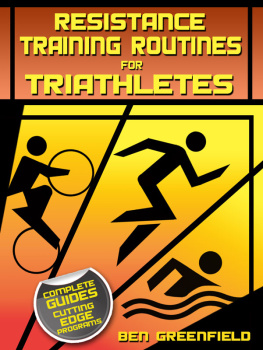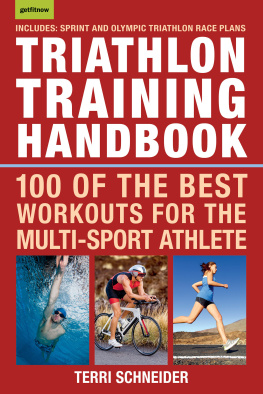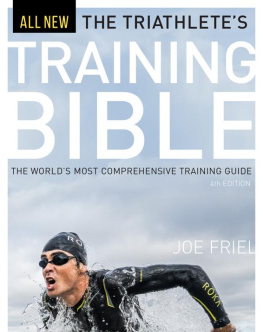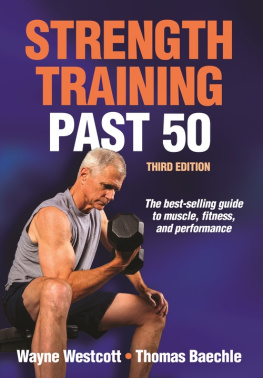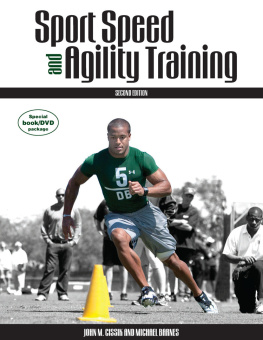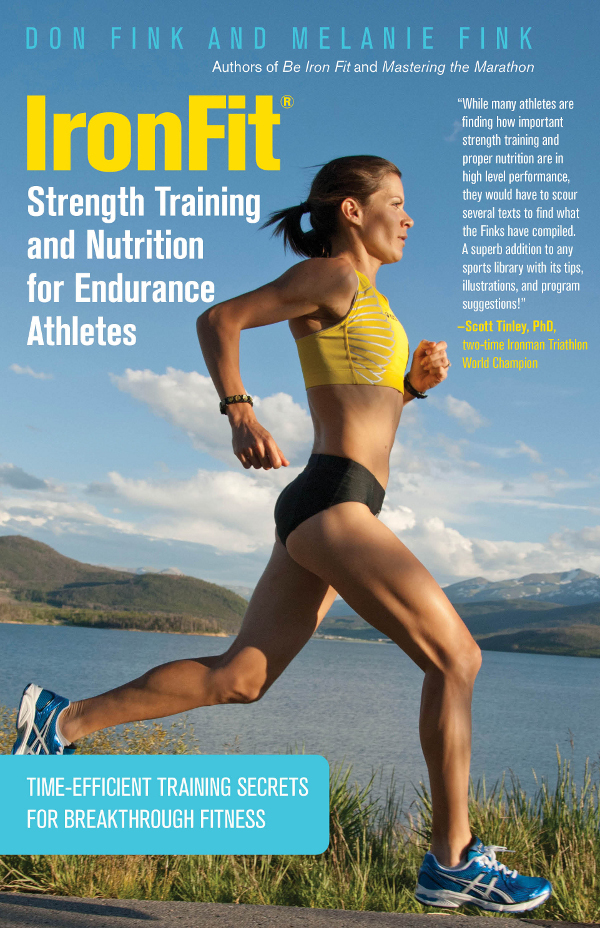
Copyright 2013 by Don Fink and Melanie Fink
ALL RIGHTS RESERVED. No part of this book may be reproduced or transmitted in any form by any means, electronic or mechanical, including photocopying and recording, or by any information storage and retrieval system, except as may be expressly permitted in writing from the publisher. Requests for permission should be addressed to Globe Pequot Press, Attn: Rights and Permissions Department, P.O. Box 480, Guilford, CT 06437.
Lyons Press is an imprint of Globe Pequot Press
Ironman and Ironman Triathlon are registered trademarks of the World Triathlon Corporation
IronFit is a registered trademark of Don Fink
All exercise technique photos featuring Yvonne Hernandez are provided courtesy of Lynn Kellogg/www.trilifephotos.com.
Text design and layout: Mary Ballachino
Project editor: Ellen Urban
Library of Congress Cataloging-in-Publication Data is available on file.
ISBN 978-0-7627-9173-6
MEDICAL DISCLAIMER
The programs in this book are designed for athletes with either a high level of fitness or the physiology to attain a high level of fitness. Readers should consult a physician before beginning any of the workouts suggested herein. If you experience any pain or difficulty with these exercises, stop and consult your health-care provider.
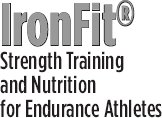
Also by Don Fink
Be Iron Fit: Time-Efficient Training Secrets for Ultimate Fitness Mastering the Marathon: Time-Efficient Training Secrets for the 40-plus Athlete
To our loving parents,
Esther and Martin and Claire and Richard
Strength training and nutritionthey go hand in hand. Its not always easy to see the relationship, but in addition to the sport-specific training of an endurance athlete (the actual running, cycling, swimming, etc.), the proper combination of strength training and nutrition can make the difference between merely improving and breaking through to entirely new levels of competitive performance.
When we say strength training, we are referring not only to traditional weight lifting at the gym; were also talking about core and functional strength trainingabout developing core muscles and muscle/movement balance, as well as enhancing each of the movements specific to an athletes sport.
When we say nutrition, we are not just talking about what a person eats and drinks each day, although this is important, and well discuss it in great detail. We are also talking about what we eat and drink before, during, and after training sessions and competitions to prepare our bodies to perform at our highest levels, and to recover healthily after great exertion.
This book will help any athlete who is training and competing in any endurance event or sport. By adding the proper strength-training program and nutritional approach, any good sport-specific training plan can be converted into something truly amazing. The programs in this book are designed to work especially well with our triathlon-specific training programs in Be Iron Fit, and our marathon-specific programs in Mastering the Marathon, but they can also be used with any sport-specific program an athlete has undertaken to create truly exceptional training.
This book is divided into nine major sectionsfour of which are packed with actual programs and routines that an athlete can put into action to derive immediate benefits.
First, we discuss strength training and how we can properly use it to build functional strength and muscle/movement balance crucial to endurance sports athletes while also using it to make us less injury-prone. We will move beyond the traditional strength-training approaches of static machines to examine the new cutting-edge approaches to building functional, dynamic, and sport-specific strength and power. While we may still use some traditional equipment like dumbbells, we will approach their use with a focus on functional training. We will combine traditional equipment with the use of the stability ball (Swiss ball), foam roller, BOSU ball, and other effective functional strength- and core-training equipment.
This book details nine specific strength-training programs, each tailored to different types of endurance athletes. While each of the programs has similar philosophies and approaches, they are built upon the principle that different sports require different focuses. The nine programs presented here each focus on a particular sport with progressions for each exercise. The athlete may begin at the basic level, and as he or she gets stronger, each exercise offers up to two progressions.
In addition to the nine sport-specific strength-training programs, this book also offers several special programs to further enhance an athletes training. These include efficient warm-up and stretching routines that can be used with any of the strength and core programs. Breathing and mental exercises are described to help the athlete get centered and focused for the challenge ahead. We even include a special travel program for the athlete who is traveling without access to gym facilities. This program can be done in a hotel room and requires little to no equipment.
Each strength program is designed to be time-efficient, effective, and fun. Busy athletes training for endurance sports dont have the time for long, complicated, and often boring workouts. Each workout in this book is fine-tuned to ten or fewer time-efficient, fun, and results-oriented exercises.
In , we move from strength training to a discussion about nutrition. We describe what an athlete needs to eat and drink before, during, and after training and competition, as well as how an athlete should approach day-to-day nutrition for best results.
We will discuss overall healthy eating for endurance athletes, presenting our approach to six small daily meals, and we will explain how to balance these meals properly between proteins, fats, and carbohydrates, while keeping overall calorie consumption in mind. We will also provide tools to help athletes determine how many calories should be consumed each day to achieve and maintain optimal race weight.
The next chapter presents five complete seven-day healthy eating plans. Using daily calorie targets and other factors, we explain how the athlete will select the plan that fits him or her best. From here, the athlete will learn how to make ongoing substitutions to the seven-day regimen to create a healthy eating plan for life.
Following nutrition, we discuss the crucial topic of hydration. We will explain hydrations great importance and the impact it has on our performance, and also present the tools athletes can use to precisely determine their unique hydration needs, no matter the race and the conditions. We discuss the logistics of hydration and how to develop a personalized hydration routine.
We then tackle the subject of what we like to call fueling. provides our specific nutritional plan to be used before, during, and after training and competition. The information in this chapter allows athletes to determine their own unique optimal fueling requirements, along with racing logistics and other needs.
Finally, we offer complete fueling and hydration plans for eight experienced and accomplished endurance athletes. These plans include exactly what the competitors eat and drink before, during, and after both training and racing for best results. In addition to these successful battle-tested plans, we present the tools needed to fine-tune these plans to perfectly fit each athlete.


